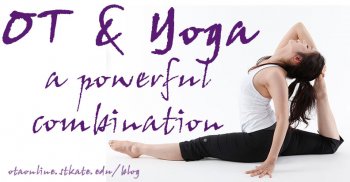
Finding a career that makes you happy is about finding a job where you can incorporate your interests.
For those who enjoy exercising and leading a generally healthy lifestyle, choosing a career in occupational therapy allows you to do what you love while making a difference. But how? You can blend occupational therapy and yoga to improve the lives of your patients and still keep your own healthy lifestyle on track.

Occupational Therapy and Yoga
Although yoga isn’t typically considered a life-changing exercise routine, such as running or weightlifting, it may be the perfect intervention for patients who need occupational therapy, regardless of age.
Yoga for Strength
Yoga is a great tool for improving strength in patients who may have weak muscles. Some basic moves can be used to improve core strength and muscle control. There are also many yoga positions that can be used by small children or the elderly alike.
The elderly who may have injured themselves can do yoga to improve strength and stretch out muscles. The yoga poses used in occupational therapy should depend upon the patient’s needs.
Additionally, children who may have sensory processing disorder can have yoga incorporated into their occupational therapy routine.
Yoga and Stress Relief
Occupational therapy is about more than treating physical ailments. Yoga can be used to help children and adults alike increase stamina, improve body awareness, and improve emotional health. By utilizing yoga as a stress-relief technique, you can help your patients with ADD/ADHD, autism, and more.
Beginner Yoga for OTA
These yoga poses are great for beginner occupational therapy patients.
Mountain Pose
To do mountain pose, stand upright with your feet hip-width apart. Breathe slowly and deeply, raising your arms straight above your head as you breathe.
Child’s Pose
Child’s pose, as the name implies, is a great pose for children, but is good for OT patients of all ages.









